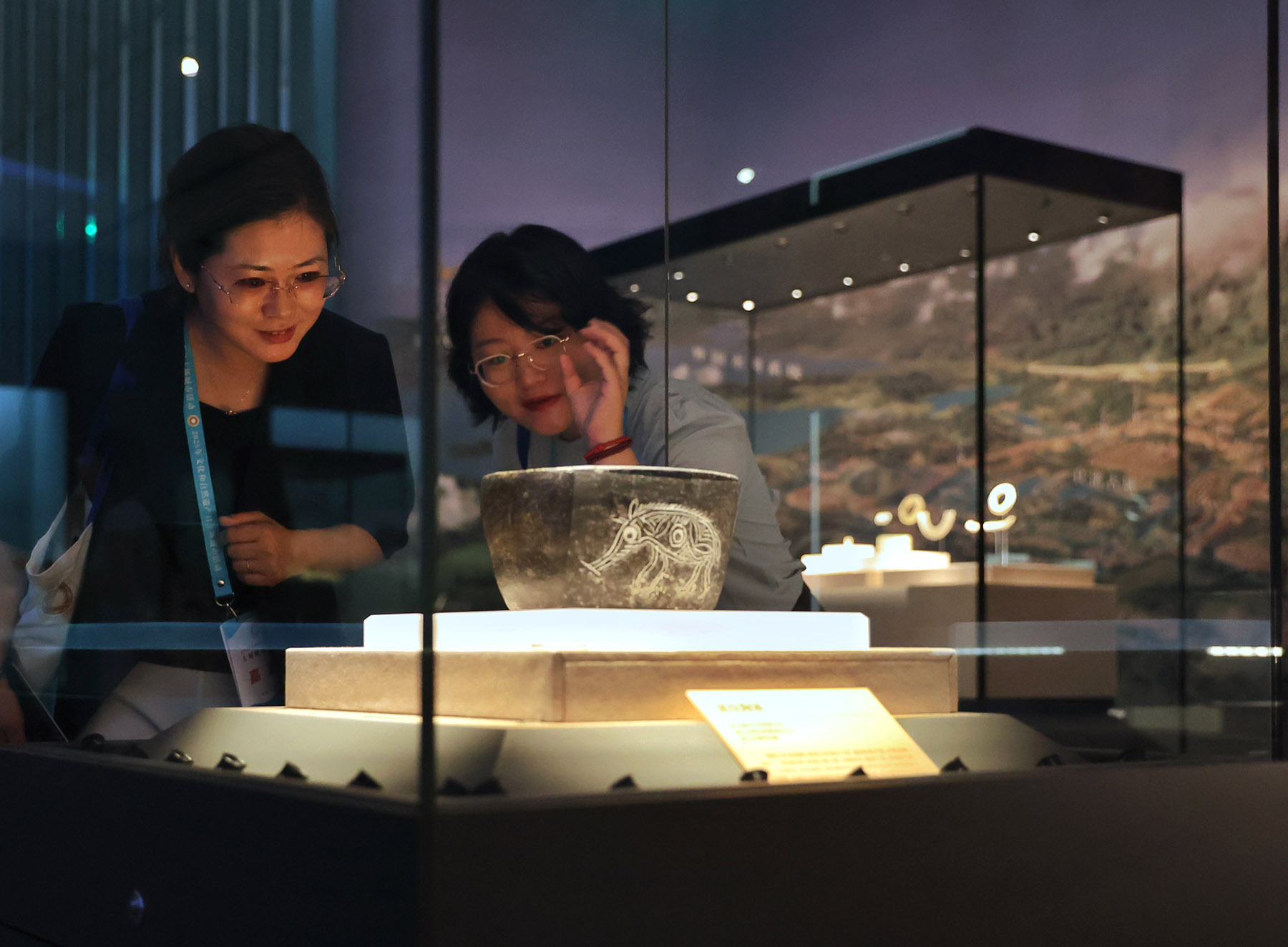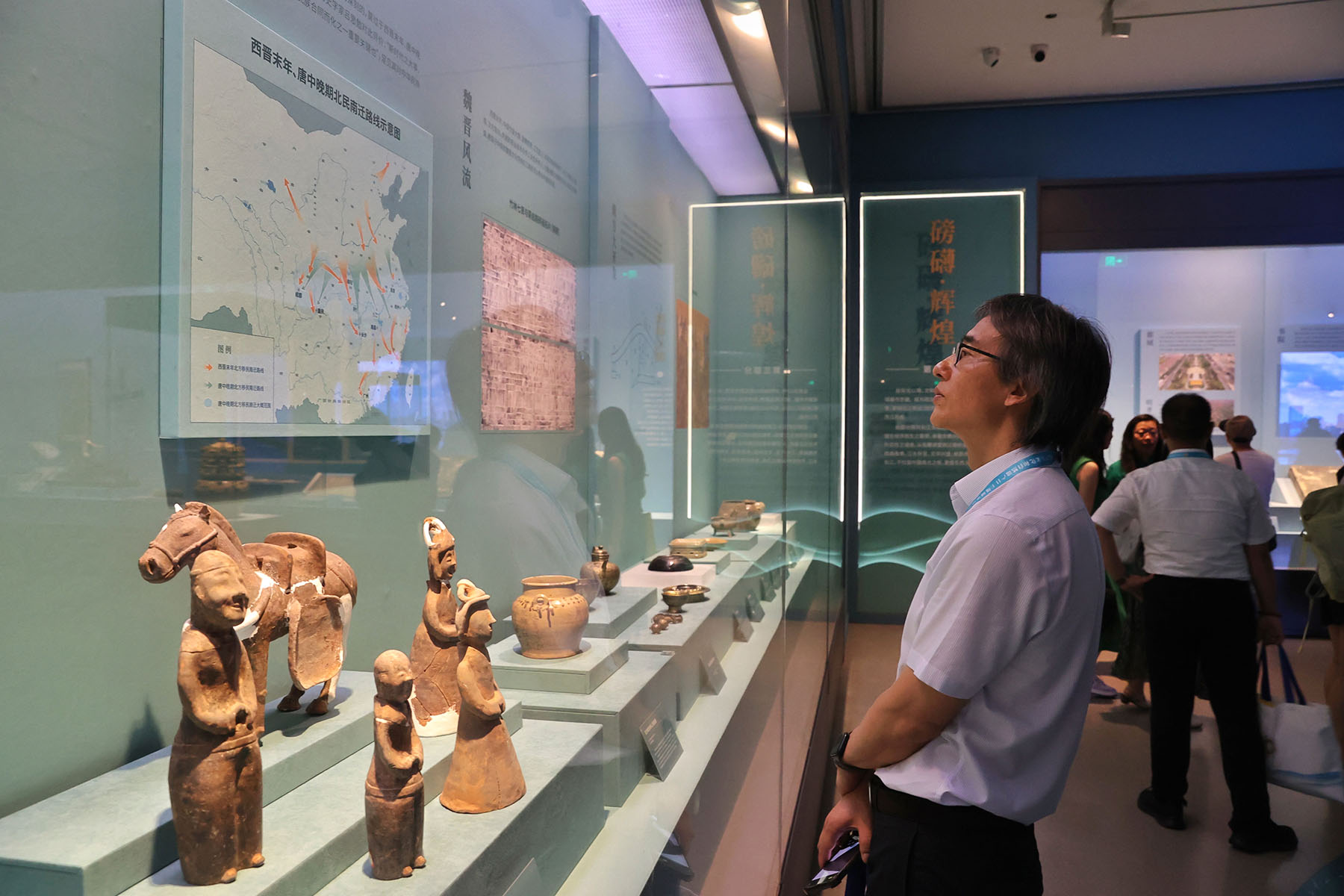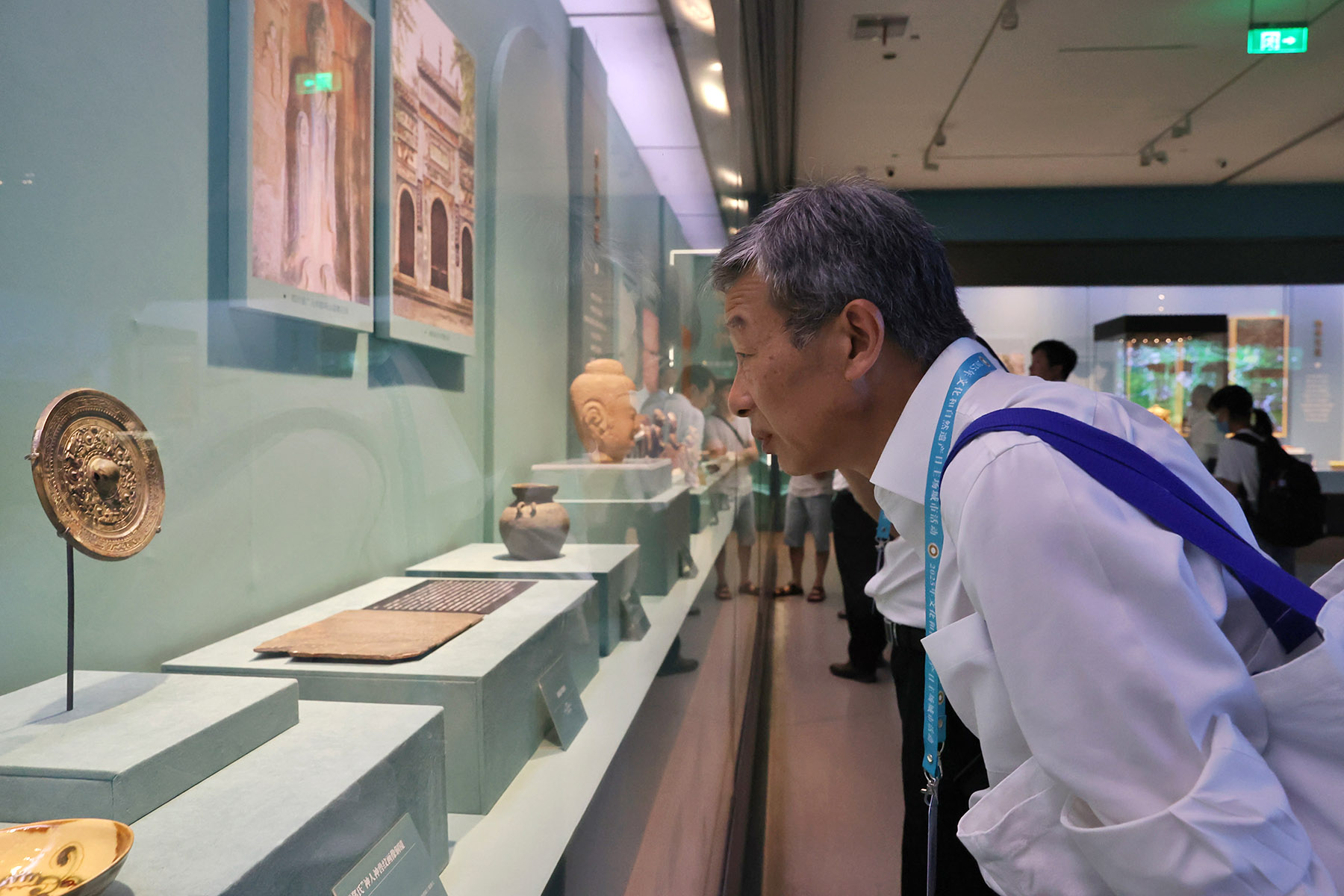Evolution of life along the banks of the river in the spotlight, Yang Feiyue reports in Changsha.

From the skull fossils of ancient humans to gleaming bronze vessels, from charred grains of prehistoric rice to exquisite embroidered silks, relics unearthed along the Yangtze River offer a glimpse into the evolution of life and culture along one of the world's greatest rivers.
Ever-flowing: Exhibition of the Yangtze River and the Chinese Civilization, which opened in mid-June at Changsha Museum in Hunan province, invites visitors on a sweeping, millennia-spanning journey.
As part of the celebrations for this year's Cultural and Natural Heritage Day that highlights the country's efforts to preserve and rejuvenate China's cultural relics, the exhibition traces the evolution of Chinese civilization along the Yangtze River — from prehistoric settlements to imperial grandeur, and into modern connectivity, through more than 200 sets of rare cultural relics on display.
It was jointly hosted by the National Cultural Heritage Administration and the Hunan government, and has brought together an unprecedented collaboration of 51 major cultural institutions, including the Palace Museum and the National Museum of China.
READ MORE: Tracing the origins of civilization
The exhibition intends to offer an immersive narrative of the region's rich historical and cultural landscape and highlight the critical role that the Yangtze River has played in the formation and development of Chinese civilization, according to the organizers of the exhibition that will last through to Oct 12.
A replica of the Homo erectus cranium from Yunxian county, Hubei province — known as the Yunxian Man, dated to nearly a million years ago, offers the first glimpse into human origins in the Yangtze River Basin, as featured in the Vital Origins chapter.
This part explores early human activities and the shared genetic roots of Chinese civilization, with highlights such as jade artifacts from the Neolithic archaeological site of Liangzhu in Zhejiang province, painted pottery and jade ware from Shijiahe site dating back about 5,900 years in Hubei province.
Though the original of the cranium is housed at the Chinese Academy of Sciences and rarely displayed, the replica is paired with a newly completed forensic facial reconstruction, unveiled publicly for the first time in December 2024, says Wang Wenbin, associate research curator at the Changsha Museum.

The two exhibits are put in a broader and relatively complete sequence of Paleolithic human remains in the Yangtze region — spanning from 1.7 million to 20,000 years ago, with the juxtaposed display of other notable finds, such as the Hexian Man dating to 200,000 years ago from Anhui province, distinguished by the rich diversity of physical traits, Wang notes.
Further down the exhibition, the basin's pioneering role in rice domestication is notably demonstrated by a centerpiece — charred rice remains from the Shangshan culture in Zhejiang — dating back over 10,000 years.
Accompanying relics giving a bigger picture include carbonized rice husks from the Jijiaocheng site dating back to between 5,300 and 4,000 years in Hunan, as well as paddies and various earth-turning implements from iconic ancient sites such as Yuchanyan in Hunan and Hemudu in Zhejiang that are believed to be used like modern shovels.
"These remains offer decisive evidence that early Yangtze communities were actively cultivating rice," Wang says.
In particular, a stunning black pottery vessel from the Zhejiang Provincial Museum, painted on both sides with wild boars, suggests early animal domestication and artistic representation, Wang points out.
"The object itself also demonstrates advanced pottery carbonization techniques from over 7,000 years ago," he adds.
The last bit of the section features a display of silkworm cocoons and woven fabrics from sites like Qianshanyang of Zhejiang province dating back more than 4,000 years, which illustrated another major contribution of the Yangtze civilization to silk weaving. "These advances were linked to broader themes of innovation and adaptation in prehistoric society," he says.
Arrays of imposing bronze items of various shapes and sizes take center stage at the Brilliant Convergence chapter that showcases how the Yangtze River contributed to the development of crafts, governance and philosophy.
Archaeological excavations from Panlongcheng (in modern-day Wuhan, Hubei province) dating back to the early Shang Dynasty (c.16th-11th century BC) reveal the earliest adoption of Central Plains bronze technology, says Fang Fang, co-curator behind the chapter.
"Here, ritual wine vessels like the jue and jia sets show remarkable similarity to the prototypes of Erlitou culture (dating to between 3,750 to 3,520 years ago in today's Henan province), particularly in their arrangement and casting techniques," Fang says. "However, subtle local adaptations already appear in details like tapered legs and miniature beast masks, signaling the beginnings of a distinctive southern bronze tradition."

Bronzeware exhibits from the Sanxingdui culture (estimated to be 3,000 to 3,600 years old) in Sichuan province reveal extraordinary mythological hybrid creatures that blended human and animal features. Further east, large lei wine containers found in Hunan from the Shang Dynasty adorned with aquatic motifs reflected the region's wetland ecology, while the eastern Jiangxi province-based Wucheng culture from the Shang period developed its own avian-inspired designs, exemplified by the bird-eared ding tripod.
"These regional variations demonstrate how bronze technology served as a medium for expressing local environmental and spiritual relationships while maintaining connections to Central Plains ritual systems," Fang explains.
Perhaps most revealing are bronze items from a tomb of a Qin (221-206 BC) general found in Yunmeng county, Hubei province.
He was buried with both northern-style tripods and Chu-style (a vassal state over 2,000 years ago) gui ritual bronze vessels.
"The hybrid motifs blended Qin militaristic imagery with Chu shamanistic symbols — illustrating how bronze objects facilitated cultural (interactions) during the turbulent Warring States Period (475-221 BC)," Fang notes.
The third chapter, Magnificent Momentum, explores the Yangtze River's transformative influence from the Song Dynasty (960-1279) onward. This period saw the region emerge as a nexus of political thought, educational reform, commercial expansion and cultural expression. From renowned academies and thriving textile industries to imperial examination records and theatrical art, the Yangtze River Basin became a dynamic engine of imperial innovation.
Following the Southern Song Dynasty (1127-1279)'s relocation of the capital to Lin'an (in modern-day Hangzhou, Zhejiang province), the Yangtze River Basin began to assume increasing importance, as a hub of political thought and statecraft, says Wang.
"This prominence was further solidified in the early Ming Dynasty (1368-1644), when Zhu Yuanzhang established the Ming capital in Nanjing. The Yangtze region thus became the administrative and institutional heart of the empire."
Several artifacts speak powerfully to this ascendancy. A cloud-scroll patterned stone column head from ruins of Ming royal palace in Nanjing exemplifies how southern palace architecture influenced the later construction of the Forbidden City in Beijing, Wang says.
"Although the Nanjing palace now exists only in fragments, its layout and ornamentation set precedents that were later expanded upon in the northern capital," he says.
Likewise, a set of imperial roof tiles and drip tiles from the Xiaoling Mausoleum of the Ming Dynasty reflects the symbolic authority vested in imperial design.
ALSO READ: Quietly redefining the ink tradition
"The yellow glaze and five-clawed dragon motifs conform to the strict sumptuary codes of the Ming dynasty, underscoring the ceremonial power radiating from the Yangtze region at that time," Wang says.
Another highlight is a floor tile known as a "golden brick", produced in Suzhou, Jiangsu province, and used exclusively in royal architecture. Remarkable for its metallic resonance when struck, this brick included engraved details such as the name of the craftsman and date of manufacture, offering rare insights into the regulated production systems that underpinned imperial infrastructure.
Beyond politics, the exhibition also sheds light on the refinement of textile craftsmanship, as seen in a Ming-era Yun brocade sample and a model of a Song Dynasty loom from the lower reaches of the Yangtze River. As Chinese silk and embroidery flooded global markets during the Ming and Qing (1644-1911) periods, the Yangtze region became an economic engine powering both domestic and international exchange, Wang says.
"These insights help decode the river's significance not only as a geographical feature, but also as a historical force that shaped identity, governance and creativity," he says.
Ultimately, the Yangtze exhibition invites viewers to reflect on the deep currents of history flowing through this vital waterway and calls for renewed public engagement in protecting and studying this civilizational artery, especially as modern development increasingly intersects with cultural heritage conservation, he adds.
Contact the writer at yangfeiyue@chinadaily.com.cn


